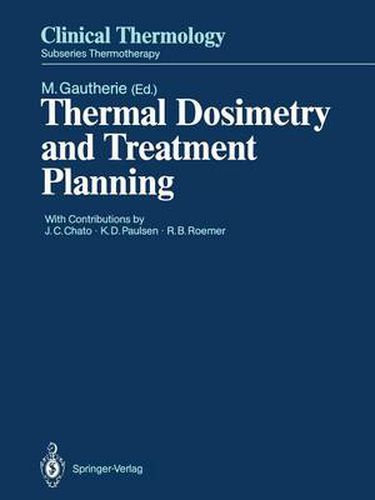Readings Newsletter
Become a Readings Member to make your shopping experience even easier.
Sign in or sign up for free!
You’re not far away from qualifying for FREE standard shipping within Australia
You’ve qualified for FREE standard shipping within Australia
The cart is loading…






This title is printed to order. This book may have been self-published. If so, we cannot guarantee the quality of the content. In the main most books will have gone through the editing process however some may not. We therefore suggest that you be aware of this before ordering this book. If in doubt check either the author or publisher’s details as we are unable to accept any returns unless they are faulty. Please contact us if you have any questions.
When in the future improved and more flexible heating equipment becomes available, and when hyperthermia is applied more routinely, computerized simulations of treatments will become commonplace, as they are in radia tion therapy. For hyperthermia, however, such simulations will be used not only for the traditional role of planning patient treatment, but also for three other applications not needed in radiation therapy - the comparative evalu ation of equipment, feedback control during treatment, and the post-treat ment evaluation of therapy. The present simulations of hyperthermia are crude and simple when compared with what is required for these future ap plications, a fact which indicates the nedd for considerable research and de velopment in this area. Indeed, this research is proceeding rapidly within the hyperthermia community, whre three-dimensional power deposition and temperature calculations have just become available for realistic patief\t anatomies. Of equal significance are the even more rapid development in diagnostic imaging for the determination and display of patient anatomy and blood flow rates - information required for the planning of realistic hyperthermia treatment. These simulations will be very valuable tools which can be used to great ad vantage when combined with data obtained from treatments of patients.
$9.00 standard shipping within Australia
FREE standard shipping within Australia for orders over $100.00
Express & International shipping calculated at checkout
This title is printed to order. This book may have been self-published. If so, we cannot guarantee the quality of the content. In the main most books will have gone through the editing process however some may not. We therefore suggest that you be aware of this before ordering this book. If in doubt check either the author or publisher’s details as we are unable to accept any returns unless they are faulty. Please contact us if you have any questions.
When in the future improved and more flexible heating equipment becomes available, and when hyperthermia is applied more routinely, computerized simulations of treatments will become commonplace, as they are in radia tion therapy. For hyperthermia, however, such simulations will be used not only for the traditional role of planning patient treatment, but also for three other applications not needed in radiation therapy - the comparative evalu ation of equipment, feedback control during treatment, and the post-treat ment evaluation of therapy. The present simulations of hyperthermia are crude and simple when compared with what is required for these future ap plications, a fact which indicates the nedd for considerable research and de velopment in this area. Indeed, this research is proceeding rapidly within the hyperthermia community, whre three-dimensional power deposition and temperature calculations have just become available for realistic patief\t anatomies. Of equal significance are the even more rapid development in diagnostic imaging for the determination and display of patient anatomy and blood flow rates - information required for the planning of realistic hyperthermia treatment. These simulations will be very valuable tools which can be used to great ad vantage when combined with data obtained from treatments of patients.